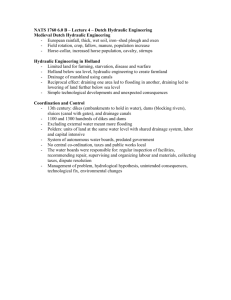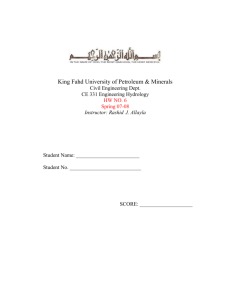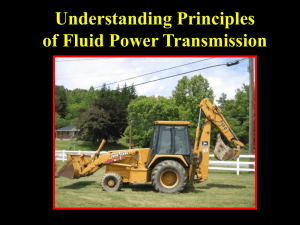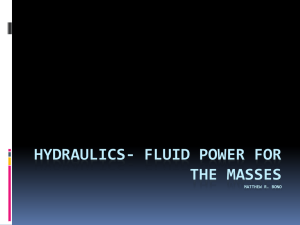2014 Ivanov O. N., PhD, Senior Lecture, Arendarenko V. N., PhD
advertisement
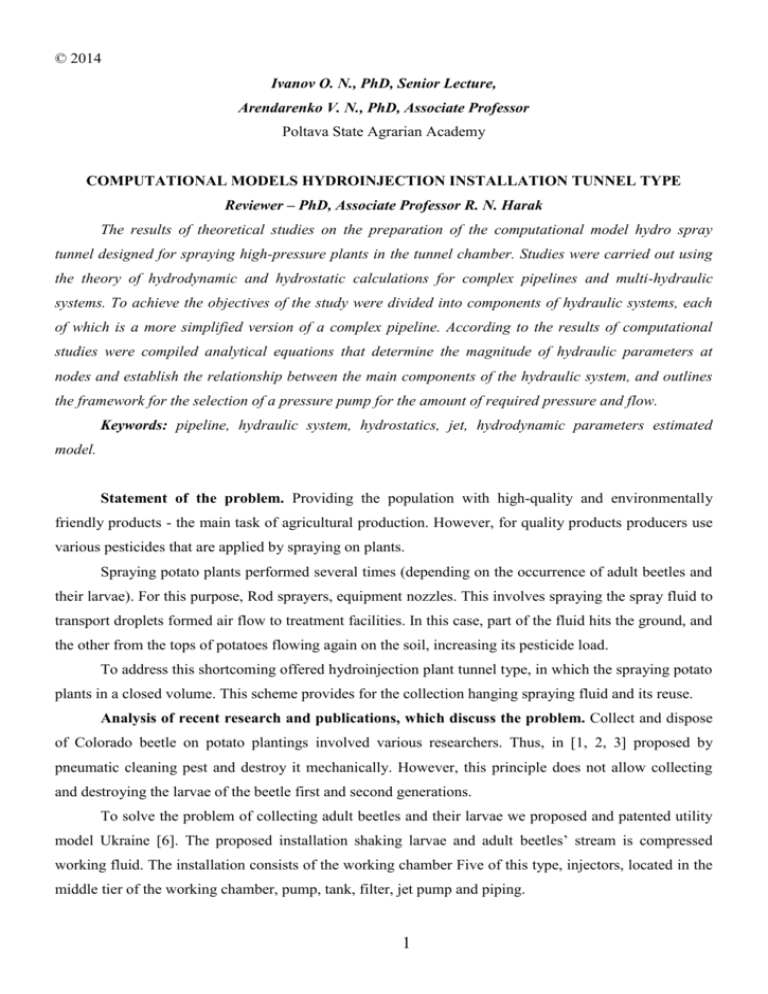
© 2014 Ivanov O. N., PhD, Senior Lecture, Arendarenko V. N., PhD, Associate Professor Poltava State Agrarian Academy COMPUTATIONAL MODELS HYDROINJECTION INSTALLATION TUNNEL TYPE Reviewer – PhD, Associate Professor R. N. Harak The results of theoretical studies on the preparation of the computational model hydro spray tunnel designed for spraying high-pressure plants in the tunnel chamber. Studies were carried out using the theory of hydrodynamic and hydrostatic calculations for complex pipelines and multi-hydraulic systems. To achieve the objectives of the study were divided into components of hydraulic systems, each of which is a more simplified version of a complex pipeline. According to the results of computational studies were compiled analytical equations that determine the magnitude of hydraulic parameters at nodes and establish the relationship between the main components of the hydraulic system, and outlines the framework for the selection of a pressure pump for the amount of required pressure and flow. Keywords: pipeline, hydraulic system, hydrostatics, jet, hydrodynamic parameters estimated model. Statement of the problem. Providing the population with high-quality and environmentally friendly products - the main task of agricultural production. However, for quality products producers use various pesticides that are applied by spraying on plants. Spraying potato plants performed several times (depending on the occurrence of adult beetles and their larvae). For this purpose, Rod sprayers, equipment nozzles. This involves spraying the spray fluid to transport droplets formed air flow to treatment facilities. In this case, part of the fluid hits the ground, and the other from the tops of potatoes flowing again on the soil, increasing its pesticide load. To address this shortcoming offered hydroinjection plant tunnel type, in which the spraying potato plants in a closed volume. This scheme provides for the collection hanging spraying fluid and its reuse. Analysis of recent research and publications, which discuss the problem. Collect and dispose of Colorado beetle on potato plantings involved various researchers. Thus, in [1, 2, 3] proposed by pneumatic cleaning pest and destroy it mechanically. However, this principle does not allow collecting and destroying the larvae of the beetle first and second generations. To solve the problem of collecting adult beetles and their larvae we proposed and patented utility model Ukraine [6]. The proposed installation shaking larvae and adult beetles’ stream is compressed working fluid. The installation consists of the working chamber Five of this type, injectors, located in the middle tier of the working chamber, pump, tank, filter, jet pump and piping. 1 Purpose and objectives of the research. The goal of the proposed research is to design a model drawing hydraulic tunnel injection installation using guidelines theories of hydrostatics and hydrodynamics for use in further theoretical studies of the identification and coordination of hydraulic parameters and characteristics of the main components of the installation. The objective of the proposed research is prompting a clear mathematical algorithm to identify key points in hidroparametriv designs with complex pipelines and varied in character and principle of the hydraulic elements. Results. Schematic diagram of hydraulic tunnel hydroinjection installation is shown in Fig. 1 as well. The installations of large volume tank, from which by means of centrifugal pump is the selection of fluid and pumping it under high pressure to a large number of nozzles in the spray chamber (Fig. 1b). Number of nozzles and the nature of their location in the middle of the camera meets the requirements of effective spraying process. In order to save injection fluid of the installation is collecting tank, the use of which allows to collect and store the portion of liquid that does not get the object spraying and naturally flows down from the surface of the object. For pumping the collected fluid is introduced to the installation jet pump and filter which cleans the flow of fluid from mechanical and plant additives. Injection flow jet pump is forked part of the main hydraulic flow supplied to staff centrifugal pump installation to the injectors spraying chamber. а) b) Figure 1. Schematic diagram of the hydraulic unit (a) and general view of the camera injection (b) Addressing the task of drawing up computational model of hydraulic system with complex pipelines involves partitioning a single design into elementary parts, which would represent a set of common piping and the calculation is reduced to the application of the law (equation) Bernoulli [4] and the continuity equation flow fluid. In this regard, hydraulic diagram of the apparatus (Fig. 1,a) is divided into separate components (Fig. 2). Consider each component in particular. 2 a) b) d) c) e) f) g) Figure 2. Separation of the components of the hydraulic system The first component in Fig. 2, and is a hydraulic rod with multiple nozzles that is connected to the input node C. Calculate the nodal point for a given hydraulic pressure Pc and the value of working fluid (QC). The total value of expenses QC is defined as the total cost of liquid through each nozzle, which are attached to the rod [5]: QC Qô 1 Qô 2 ... Qô n , (1) where Qô 1 , Qô n − magnitude of fluid flow through the first and n-well injector. If the nozzles are the same type and have the same regulation, the flow rate through each of them will be the same. Then the total cost is equal to QC: QC n Qô , (2) where n – number of nozzles on the boom. To determine the pressure Pc compose the Bernoulli equation for the two sections of the plane of comparison that passes through the point P. The first section passing through point C, the other - in the cross section of the output of the first injector nozzle. Weighing pressures neglected as a starting point C and injector nozzle lie on a horizontal plane. With this in mind, the Bernoulli equation has the form: pc 2 vc2 pàòì 2 vô21 pòð p ì³ñ . This pressure is equal to PC: 3 (3) pc pàòì v 2 2 ô1 vc2 pòð p ì³ñ , (4) where: pàòì – atmospheric pressure; – density of the fluid flow; vô 1 – flow rate in the initial nozzle injectors; v c – flow rate at the point of С; pòð – pressure drop along the length of the pipeline; p ì³ñ – loss of hydraulic pressure on local obstacles. Pressure loss along the length and the local support can be found by formulas Veysbaha and Darcy-Veysbaha [5]: pòð 2 dñ p ì³ñ vc2 . vô21 2 (5) . (6) Losing the pressure p ì³ñ is defined as the total loss eneriyi fluid flow inside the nozzle flow at him from point C to the output end of the nozzle. We make some simplifying analytical expression that defines the flow rate in a pipe section; we define the value of the flow rate [4]: v Q 4Q . S d 2 (7) Then formula (5) and (6) has the form: p òð 8 2 Qc . 2 d c5 p ì³ñ 8 Qô21 . 2 4 dô1 (8) (9) In equations (5) and (6), (8) and (9) perform the following options: Cô 8 . 2 d ô41 (10) Cñ 8 . 2 d ñ4 (11) 4 ÊÑ 8 . 2 d c5 Ê ô (12) 8 . 2 dô41 (13) In view of the above replacements formula (4) takes the following form: pc pàòì Ñô 1 Qô21 Ñc Qc2 K c Qc2 K ô 1 Qô21 . (14) By combining all common components of equation (14) and introducing provided below replacement, Z ô Cô 1 K ô 1 ; (15) Yc K C CC . (16) final value equation hydraulic pressure Pc will form: pc pàòì Z ô Qô21 Yc Qc2 . (17) Similarly equations consist of hydraulic pressure Pc against other jets. In general, the pressure Pc is determined through the same type of equations, for each of the nozzles. Neglect largest loss of hydraulic pressure along the length of piping from the point C to a single injector (insignificant value hydraulic circuit for this). Then the magnitude of the pressure Pc is determined only by equation (17). Thus, the following system of equations to fully determine all the unknown hydraulic parameters for point C: QC n Qô ; 2 2 pc pàòì Z ô Qô Yc Qc . (18) Using the method shown above, determine the required hydraulic parameters for points A and B (Fig. 2b): Q A n Qô ; 2 2 p A p àòì Z ô Qô YA Q A . (19) QB n Qô ; 2 2 p B p àòì Z ô Qô YB QB . (20) We turn to the calculation of the point O1 (Fig. 2, b). Since the point O1 is a common entrance for points A, B and C, the flow QO1 will be determined by the following expression: QO1 QA QB QC . 5 (21) In terms of uniformity costs through the points А, В, С Q A QB QC . (22) Consumption QO1 will be calculated: QO1 n QA , (23) where n – number of output lines from point O1 with the same flow. According to Bernoulli's equation the pressure pO1 determined: pO1 p A g O1 A where O A 1 8 Q A2 , 2 4 dA (24) − total pressure loss coefficient at the transition from point A to point O1. To simplify the expression, do the following replacement: 8 g 2 Z A O1 A 2 4 . dA (25) Then the pressure at point O1 is determined: pO1 p A Z A QA2 . (26) Preparation of (26) with respect to the points B and C is carried out by the above method. Then the pressure pO1 value will be determined by the following system of equations: pO p A Z A Q A2 ; 1 2 pO1 p B Z B QB ; 2 pO1 pC Z C QC . (27) To the point O1 calculation of hydraulic parameters by the system: QO1 pO1 pO1 pO1 n QA p A Z A Q A2 ; p B Z B QB2 ; (28) pC Z C QC2 . Method of simultaneous equations for the bottom row of nozzles (Fig. 2) and nodal points F, E, O2 is appropriate, therefore give only the final results: Point F: QF n Qô ; 2 2 p F p àòì Z ô Qô YF QF . Point E: 6 (29) QE n Qô ; 2 2 p E p àòì Z ô Qô YE QE . (30) QO2 n QE 2 p O2 p E Z E Q E ; 2 pO2 p F Z F QF . (31) Point O2: To the point of D2 (Fig. 2, d) satisfy altitude location reference points O1 and O2 and taking as a basis the foregoing method of calculation of hydraulic parameters, in particular for the O2 terms, we obtain: QD2 QO1 QO2 ; 2 p D2 gz1 pO1 Z O1 QO1 ; 2 p D2 gz2 pO2 Z O2 QO2 . (32) Consistency of the point D is the calculation of hydraulic pressure and flow rate for point H (Fig. 2, f). For her, the system of equations has the form: QH QD1 QK ; 2 p H gz3 p D1 Z D1 QD1 ; p H gz4 p K Z K QK2 . (33) Define the desired amount of pressure to be a centrifugal pump to meet the needs received good value pressure (flow rate) through nozzles with all hydraulic losses in the system. As is known, the magnitude of the pressure pump is defined as the difference between the energy flow of fluid between its output and input: píàñîñ Eâèõ Eâõ . (34) Output energy flow is the expression: Eâèõ p H 2 v H2 . (35) The value of pressure p H and velocity v H of fluid is determined from the system of equations (33). To find the energy flow of the liquid at the inlet up a Bernoulli equation for the two cross sections 0-0 and 1-1 (Fig. 2, f): pàòì g z5 p1 2 7 vP2 p ì³ñ . (36) Then Eâõ : Eâõ pP 2 vP2 pàòì g z5 p ì³ñ . (37) The required pump pressure is determined by the following equation: píàñîñ Eâèõ Eâõ pH 2 vH2 pàòì g z5 p ì³ñ . (38) Using knowledge of the desired output pressure and flow rate, by using pressure features to select the desired discharge centrifugal pump. For jet pump (Fig. 2, g), define the desired output pressure required to pump the collected liquid in collective tank to the main tank installation. This will prepare the Bernoulli equation for the free surface of the liquid in the tank and pipe the output plane of the jet pump (point N): pN 2 v N2 g z7 pàòì 2 2 vâèõ p ì³ñ . . (39) Since the diameter of the pipeline d N d âèõ , then v N vâèõ , so that the desired pressure value will be expressed by the equation: p N g z7 pàòì p ì³ñ . . (40) For jet pump feeding the output value is the sum of labor costs and suction fluid: Q N QK QF . (41) For the initial section of the jet pump: QN QK QL ; 2 p N g z7 pàòì Z N QN . (42) Coefficient Z N is calculated by the formula (25). Take a calculation of the jet pump suction line to determine the possible level of pressure for suction of fluid from the tank. For this purpose we use the Bernoulli equation for the input section of the pump suction line (point L (Fig. 2, g)) and the free surface of precast tank. After minor changes and reductions in the value of pressure equal to: p L g z 6 p àòì Z L QL2 . (43) Coefficient Z L is calculated by the formula (25). Performance for the jet pumps suction line determined by the formula: QL 2 d âõ 4 2 ðàòì pL . (44) Combining hydraulic parameters found above, we obtain a finite system of equations estimated: 8 2 d âõ 2 ðàòì p L ; Q L 4 2 p L g z 6 p àòì Z L QL . (45) Based on these values of pressure at the outlet of the jet pump and suction line can be defined on the basis of the theory of jet devices of its type design and narrowing element. Conclusion. The mathematical algorithm for calculating hydraulic parameters in the main nodal points of hydraulic tunnel injection installation setup will allow a better understanding of the processes occurring in it, and also give a reasoned assessment of the quality of its functioning. Also developed model will allow selecting the desired discharge and jet pumps that are required to meet the technological needs and requirements to ensure the effective operation hydro injection installation. REFERENCES 1. Арендаренко В.М. Використання технічних засобів при збиранні та знищенні колорадського жука / В.М. Арендаренко. – Монографія. – Кременчук: ПП Щербатих О.В. – 2012. – 132 с. 2. А.С. 1685347 СССР А1, МКИ А01М5/08 Устройство для сбора насекомых с растений / Эргашов К., Алимухамедов С.Н., Жуйков Н.В., Кадыров А.К., Хакимов А.К., Болтабаэв Ю. (СССР). - №449410/15; Опубл. 23.10.91, Бюл. №39. – С.6 3. Гуцол Т.Д. Обґрунтування параметрів та режимів роботи пристрою для механічного збирання комах-шкідників просапних сільськогосподарських культур: автореф. дис. канд. техн. наук: 05.05.11 – «машини і засоби механізації сільськогосподарського виробництва» / Тарас Дмитрович Гуцол. – Львів, 2007. – 19 с. 4. Закон Бернулли / Википедия. Свободная энциклопедия [Електронний ресурс]. – Режим доступу: http://ru.wikipedia.org/wiki/Закон_Бернулли. 5. Лупина Т.А. Гидравлический расчет напорных трубопроводов / Т.А. Лупина, К.В.Симонов. – М.: МИИТ, 2008. – 214 с. 6. Патент на корисну модель UA 360034 України, кл. А01 М5/05. Установка для збирання та знищення колорадського жука АСЖ-1 / Арендаренко В.М., Е.Я. Прасолов, О.П. Слинько, Р.М. Харак, С.А. Браженко, Л.В. Знова, В.А. Шенель, С.В. Гладкий, О.О. Багмен, Д.О. Швець (Україна). - №200806109; заявл. 12.05.08; опубл. 10.10.08, Бюл. №19. 9



